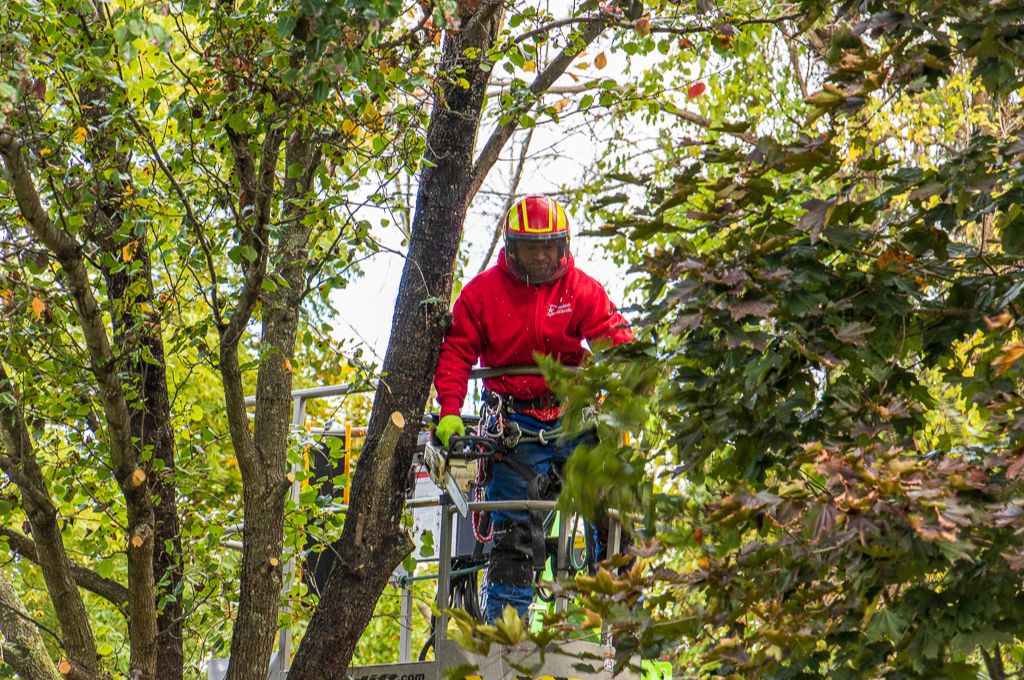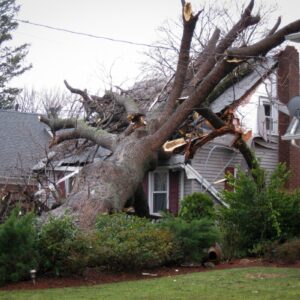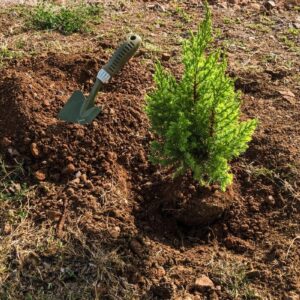Are you tired of struggling to navigate through your own yard? Not amused with having to do the limbo every time you walk under your trees? Well, you’re in luck! By strategically cutting off the bottom branches on your trees (officially called crown raising) you can increase safety and accessibility in your yard, enhance your tree’s aesthetic appeal, promote healthy growth, and prevent potential damage and hazards.
Key Takeaways
- Crown Raising Enhances Aesthetics: Properly executed crown raising can significantly improve the visual appeal and functionality of your property, contributing to higher real estate value in the MetroWest area.
- Safety is Paramount: Removing lower branches reduces the risk of safety hazards caused by overgrown branches.
- Tree Health and Growth: Crown raising promotes better air circulation and sunlight exposure, which are vital for preventing disease and supporting the overall health of the tree.
- Call in the Professionals: Professional pruning by experts like American Climbers ensures the job is done safely and effectively.
Why Remove Lower Tree Branches?
Homeowners in the MetroWest area of Massachusetts, from the historic lanes of Concord to the sprawling estates of Southborough, take pride in their tree-lined properties. Crown raising, the arboricultural technique of removing lower branches from trees, is an essential aspect of tree maintenance that serves several key purposes, from enhancing property aesthetics to ensuring the safety of your home and its surroundings.
Enhancing Curb Appeal and Property Value
A well-maintained tree not only enhances the beauty of your property but can also increase its market value. By raising the crown, you create an open, inviting, and well-cared-for look that highlights the structure of your home and the expanse of your yard. For example, a neatly pruned oak in Framingham or an elegantly shaped maple in Natick can make a striking difference in your home’s curb appeal. It’s amazing how a little trim can turn a ‘just okay’ yard into a ‘can’t-wait-to-show-it-off’ kind of space.
Promoting Tree Health and Growth
Crown raising can contribute significantly to a tree’s health and vitality. Pruning the lower branches improves airflow around the tree, which is essential in reducing the risk of fungal infections and other diseases. This is especially important if the lower branches are consistently drenched by an irrigation system or a sprinkler, which can worsen the problem.
If lower branches are diseased or pest-infested, removing them prevents the spread of these problems to the rest of the tree.
Proper pruning can also help develop a stronger, more stable structure by focusing the tree’s energy on the growth of its main branches. Overgrown lower branches can be a burden; removing them reduces the overall stress on the tree, contributing to its vitality. Cutting off damaged, misshapen, and unsightly lower branches also helps the tree remain healthy (and it looks better without those branches).
Improving Safety
Low-hanging branches can be hazardous, especially if they obstruct walkways or play areas. By pruning these branches, you reduce the risk of accidents and ensure a safer environment for everyone.
Removing lower branches also improves visibility along roads, which is particularly important in densely wooded communities like Holliston and Hopkinton. Trimming lower branches ensures clear passage on roadways and keeps street signs visible, preventing accidents and making navigation easier for everyone.
Increasing Accessibility
In addition to safety, pruning lower branches also improves accessibility. Trying to mow your lawn or navigate through your yard with branches hanging low and obstructing your path can be frustrating and time-consuming. By removing these lower branches, you are making it easier to move around your yard.
Opening Views
Giving lower tree branches a trim is like opening a window to a brighter yard. Pruning lets more sunshine in and opens your view, making your yard look bigger and more welcoming. It’s a simple touch that can really liven up your space.
Integrating with Landscape Design and Planning
Crown raising should be part of a comprehensive landscape design strategy. It allows homeowners to plan for the long-term growth of their trees and how they fit into the overall aesthetic of their property. Lower limb trimming may be necessary to clear space for expanded garden beds, installing a deck or patio, or creating a new play area for children.
Removing lower branches also allows more sunlight to reach the underplanted shrubs and your lawn, which is especially beneficial in shaded areas.
Creating Space
Have you ever thought about how much space those low-hanging branches take up? By pruning them, you can really open up your yard. It’s like giving yourself a bit more room to breathe. You’ll have more space for things like a cozy bench, a little play area for the kids, or even a new flower bed for shade-tolerant plants. It’s all about making your yard work better for you and your family.
When and How to Raise the Crown of Your Trees
The best time to perform crown raising is during the winter dormant season to minimize stress on the trees. The process involves carefully selecting and removing lower branches to achieve the desired height and appearance. It’s important to avoid over-pruning, which can damage the tree.
Young trees or recently planted ones may need extra attention as their root systems are still developing. For larger trees, such as the stately elms of Medfield, mulching around the base can provide added insulation against the cold and help reduce stress.
Best Practices for Crown Raising
- Assess the tree’s structure and determine the necessary height for crown raising.
- Use proper pruning techniques to avoid damaging the tree.
- Ensure that the tools used are sharp and clean to make precise cuts.
- Mulch around the base of the tree, keeping a few inches clear from the trunk.
Common Crown Raising Mistakes to Avoid
Pruning your trees is beneficial, but it’s easy to get a bit carried away. To make sure you’re doing more good than harm, let’s go over some common pruning mistakes you’ll want to steer clear of. Keeping these in mind will ensure your trees stay healthy and look their best.
Overdoing It
Remember, less is often more. Cutting too much can shock your tree, so it’s important to prune just enough to get the job done.
Bad Timing
Trees have their own rhythms. Pruning at the wrong time, like during their growth phase, can be harmful. The dormant season, typically late winter, is usually your best bet.
Poor Tool Care
Your pruning tools should be your best friends here. Using them when they’re dull or dirty is a no-no. Always keep them clean and sharp for a smooth cut.
Improper Cutting Technique
How you cut matters a lot. Avoid leaving large stubs or cutting too close to the trunk. Aim for just outside the branch collar – that’s the tree’s natural protective zone.
Unnatural Shapes
After pruning, your tree should still look like a tree. It’s about enhancing its natural shape, not changing it completely. Balanced pruning keeps the tree’s form and health in check.
Frequently Asked Questions
Q. What exactly is crown raising?
A. Crown raising is the process of pruning and removing lower branches from a tree to elevate the base of the tree’s crown. This technique is used for various reasons, including safety, tree health, and aesthetic purposes.
Q. Can I raise the crown of my tree myself, or should I hire a professional?
A. While some basic pruning can be a DIY task, crown raising often requires the expertise of tree care professionals to ensure it’s done correctly. American Climbers provides professional crown raising services that ensure the health and safety of your trees.
Q. How does crown raising benefit the overall health of a tree?
A. Crown raising allows for better airflow through the tree’s canopy and increases sun exposure to the tree and the landscape beneath it. This can lead to a reduction in disease and pests and promote stronger, healthier growth.
Q. Can pruning lower branches from trees harm the tree’s overall health?
A. Pruning lower branches from trees is not harmful and benefits the tree’s overall health when done properly. However, improper pruning techniques can damage a tree and lead to decay, stress, diseases, and reduced growth. It’s important to use the correct methods or hire a professional.
Q. When is the best time to perform crown raising?
A. The ideal time to prune lower branches from trees is during the dormant season, which in Massachusetts is typically in late winter or early spring. This is when the tree is not actively growing, and it reduces stress on the tree and optimizes healing.
Q. Are there any special considerations for raising the crown on particular tree species?
A. Yes. Each tree is unique. Pine trees, for instance, often need those sickly lower branches removed. Ornamental trees require a gentle touch to maintain their beauty, and fruit trees can be pruned for better harvests. It’s best to consult with a professional if you’re unsure of how to best prune your specific tree.
Consulting the Experts
While crown raising can be a DIY project for some, it often requires the expertise of tree care professionals to ensure it’s done correctly and safely. This is where American Climbers come in. Our expert pruning team has the experience and knowledge to provide top-notch crown-raising services tailored to the specific needs of your trees and property.
Crown raising is more than just cutting branches; it’s an investment in the health and beauty of your property. If you’re a homeowner looking to enhance your property’s appeal, improve safety, and ensure the health of your trees, contact American Climbers at 508-497-8628 for professional crown-raising services in Southborough, MA, and throughout the MetroWest area. Our team of skilled tree care experts will take the guesswork out of pruning and give your trees the expert care they deserve, tailored to our local Massachusetts landscape.
Blog Topics
Recent Posts
What's Happening? Stay Informed!
Stay on top of local events, pest and disease updates, tree and landscape tips, and more. Delivered straight to your inbox each month.










